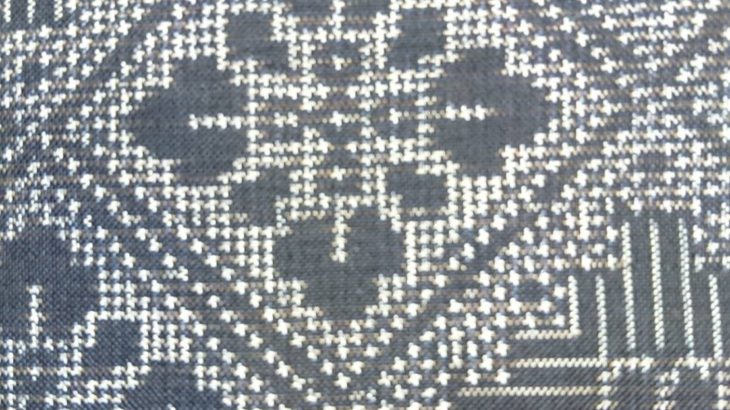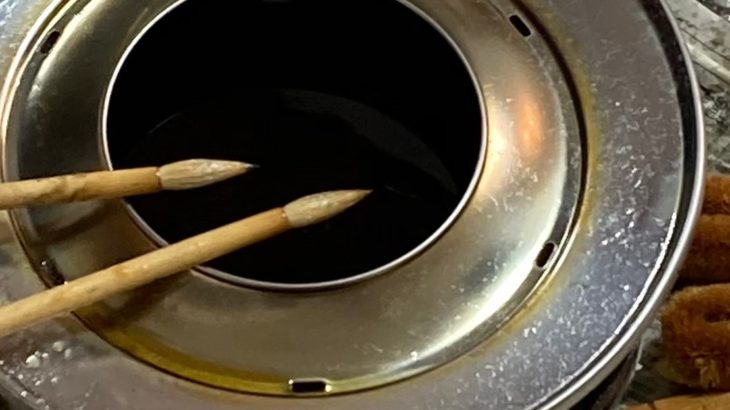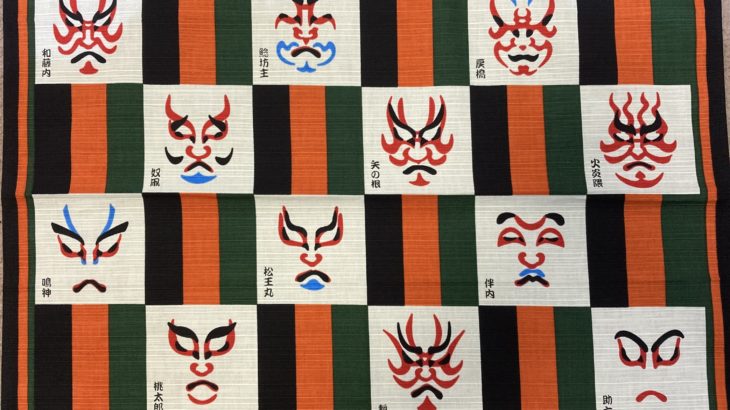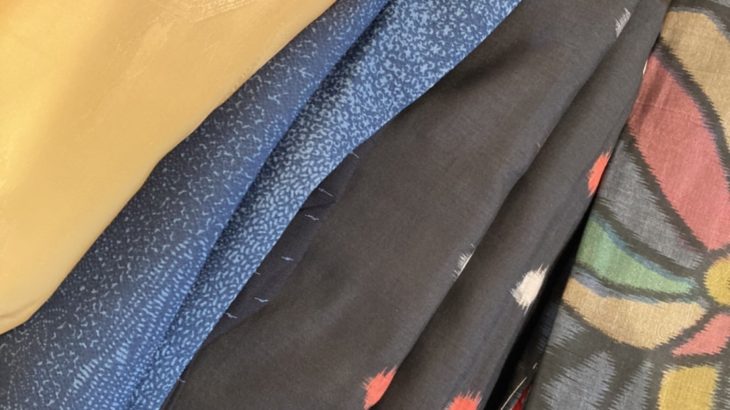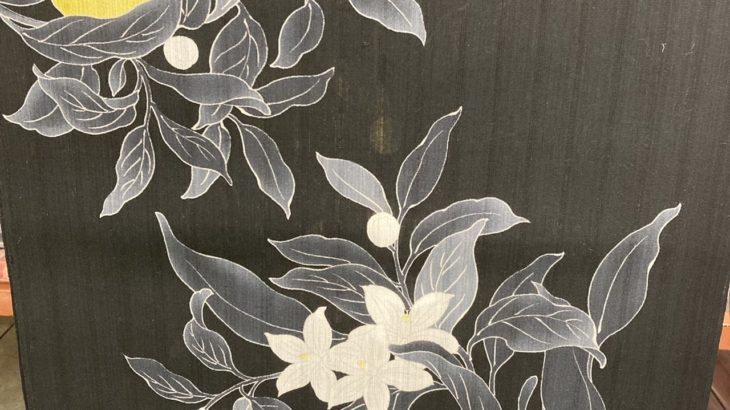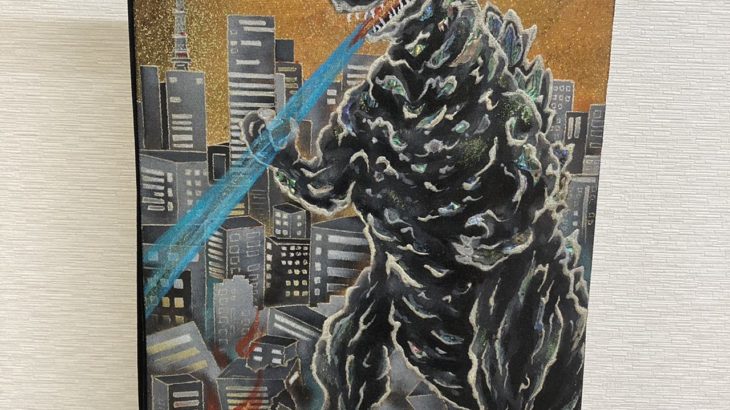Hello, this is Shinji from “Warashibe-choja.jp”. This time, I will talk about Oshima Tsumugi, which is very popular among kimonos. The kimono I made for the first time as a clerk at a kimono shop is also Oshima Tsumugi. Oshima Tsumugi is light, durable, and easy to wear, making it a very popular kimono.
- 1. Oshima Tsumugi production area
- 2. History of Oshima Tsumugi
- 3. Features of Oshima Tsumugi
- 4. Oshima Tsumugi production process
- 4.1. 1, Design production, preparation for yarn
- 4.2. 2, Ito-kuri (= thread reeling), Seikei (= The process of winding the required number of warp threads around the beam with the same length)
- 4.3. 3, Nori-hari
- 4.4. 4, Shime-bata
- 4.5. 5, Dro-zome (= mud dyeing)
- 4.6. 6, preparatory processing
- 4.7. 7, Hata-ori (= weaving)
- 4.8. 8, Product inspection
- 5. Maruki number
- 6. Yomi number
- 7. Oshima Tsumugi’s dignity
Oshima Tsumugi production area
Oshima Tsumugi is produced in Kagoshima prefecture. The large Oshima Tsumugi Cooperatives are located in Amami City, Kagoshima City, and Miyakonojo City on Amami Oshima, and each of the items recognized by the cooperative is Chikyu-jirusi (= Earth Mark) (Honba-amami-oshima-tsumugi-cooperatives). ), Hata-jirusi (= flag mark) (Honba-oshima-tsumugi-orimono-cooperatives), Tsuru-jirusi (= crane mark) (Miyakonojyo-kinu-orimono-jigyo-cooperatives) stamps are attached. In addition, there are also certificate stamps of cooperatives that disappeared in 2003, such as the Kasari-cho Oshima Tsumugi Cooperative of Taka-kura-jirusi (= Stilt warehouse mark).
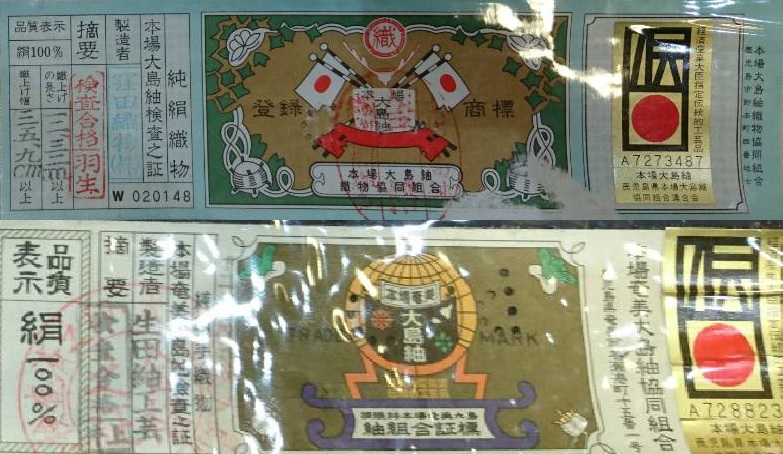
History of Oshima Tsumugi
It is said that 734 years in Kenmotsu-cho (= offering book) of Todaiji Temple in Nara is the oldest recorded history of Oshima Tsumugi.
In 1980, it was registered as a national traditional craft. A pattern is made by Kasuri of yarn-dyed Tate-ito (= warp) and Yoko-ito (= weft), and it becomes Tsumugi. Its fineness, along with French Gobelin weave and Iran’s Persian carpet, has a delicate pattern that makes it one of the world’s three largest textiles.
Features of Oshima Tsumugi
The characteristics of Oshima Tsumugi are generally said to be “light and durable”, “Kasuri is beautiful”, and “Doro-zome (= mud dyeing)”. Strictly recognized as Oshima Tsumugi …
① 100% silk.
② It is hand-woven by dyeing before weaving the thread.
③ Hira-ori. (Basics of woven fabric in which warp and weft float and sink one by one)
④ Warp and weft are processed by hand with Shime-bata.
⑤ A vertical and horizontal kasuri woven by hand with Kasuri-awase (matching the patterns of vertical and horizontal threads).
It is said that. Basically, it is woven by Taka-hata, but there are exceptions, such as white fabric for dyeing base, stripes, and machine weaving only for lattices.
In that case, the frame of the certificate stamp is orange.

Oshima Tsumugi production process
There are more than 30 processes for making Oshima Tsumugi, each of which is divided into divisions of labor by specialized craftsmen. The process is simply divided as follows.
1, Design production, preparation for yarn
Based on the original drawing and image of the design, the design is designed using a personal computer, and at the same time, the amount of unnecessary yarn is calculated.
2, Ito-kuri (= thread reeling), Seikei (= The process of winding the required number of warp threads around the beam with the same length)
Align the length and number of yarns required for the dedicated stand based on the design.
3, Nori-hari
Glue the threads so that they do not fall apart.
4, Shime-bata
Wrap it around the silk thread using cotton thread while matching it with the design to make kasuri-ito.
5, Dro-zome (= mud dyeing)
Dye repeatedly about 20 times with Techi-gi (= Wheel hawthorn) broth, which contains a lot of tannins, and dry. When it is dry, soak it in a muddy field and knead it. By repeating this process, it will be dyed in a unique, astringent and glossy ground color. It is said that the origin of Oshima Tsumugi is that the kimono was accidentally soaked in the mud and dyed in a beautiful color.
6, preparatory processing
From the dyed kasuri-ito, untie the cotton thread into a single thread. Line up the dyed kasuri-ito and do nori-hari to protect the Kasuri part.
7, Hata-ori (= weaving)
Currently, it is woven by hand using Taka-hata. Weave the tate-ito and yoko-ito Kasuri together with a needle. It is said that it takes at least one month to weave one piece.
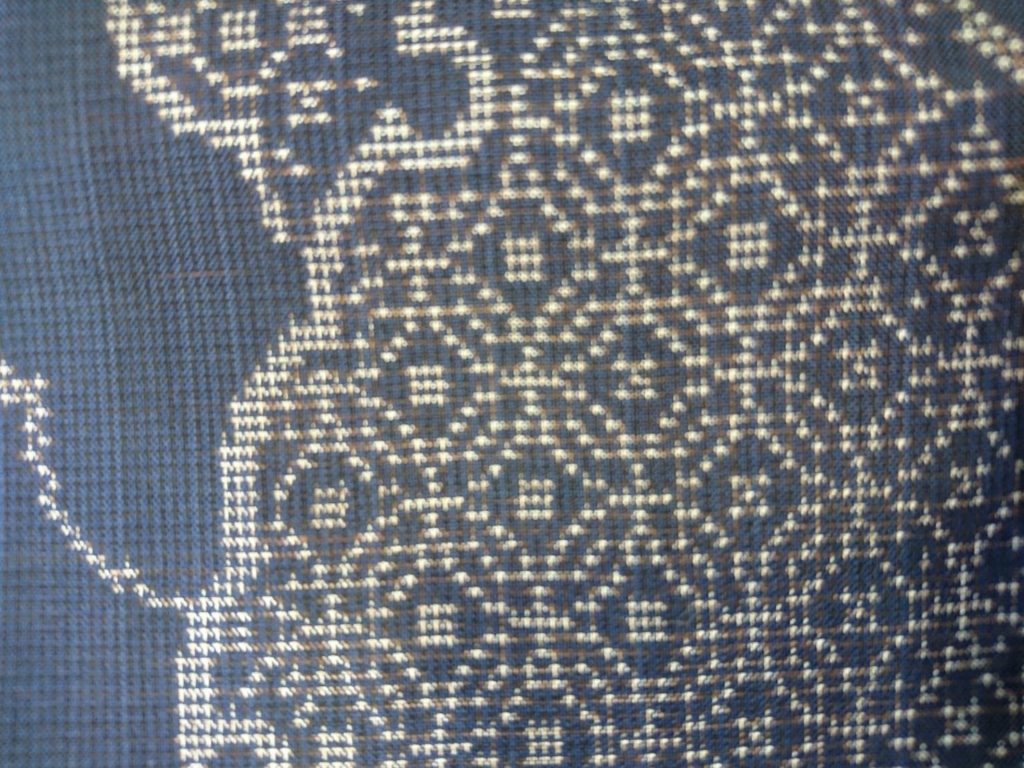
8, Product inspection
The width, length, color unevenness, Kasuri condition, etc. are checked by the cooperatives in each region, and the certificate of the cooperative is affixed to those that pass.
Maruki number
When making tateyoko-kasuri, the unit that expresses the number of kasuri-ito contained in the warp and weft is called “Maruki”. The ratio of tate-kasuri-ito to the total number of warp threads represents Maruki.
7 Maruki has 3 ground threads for 1 tate-kasuri-ito.
9 Maruki has 2 ground threads for 1 tate-kasuri-ito.
The more warp threads, the more difficult kasuri-awase is. 9 Maruki was announced in 1967, and now there are also 12 Maruki and 15 Maruki. Simply put, it is the same as the number of pixels of the camera, and as the number increases, the pattern can be expressed in detail. 12 Maruki is as shown in the figure below.
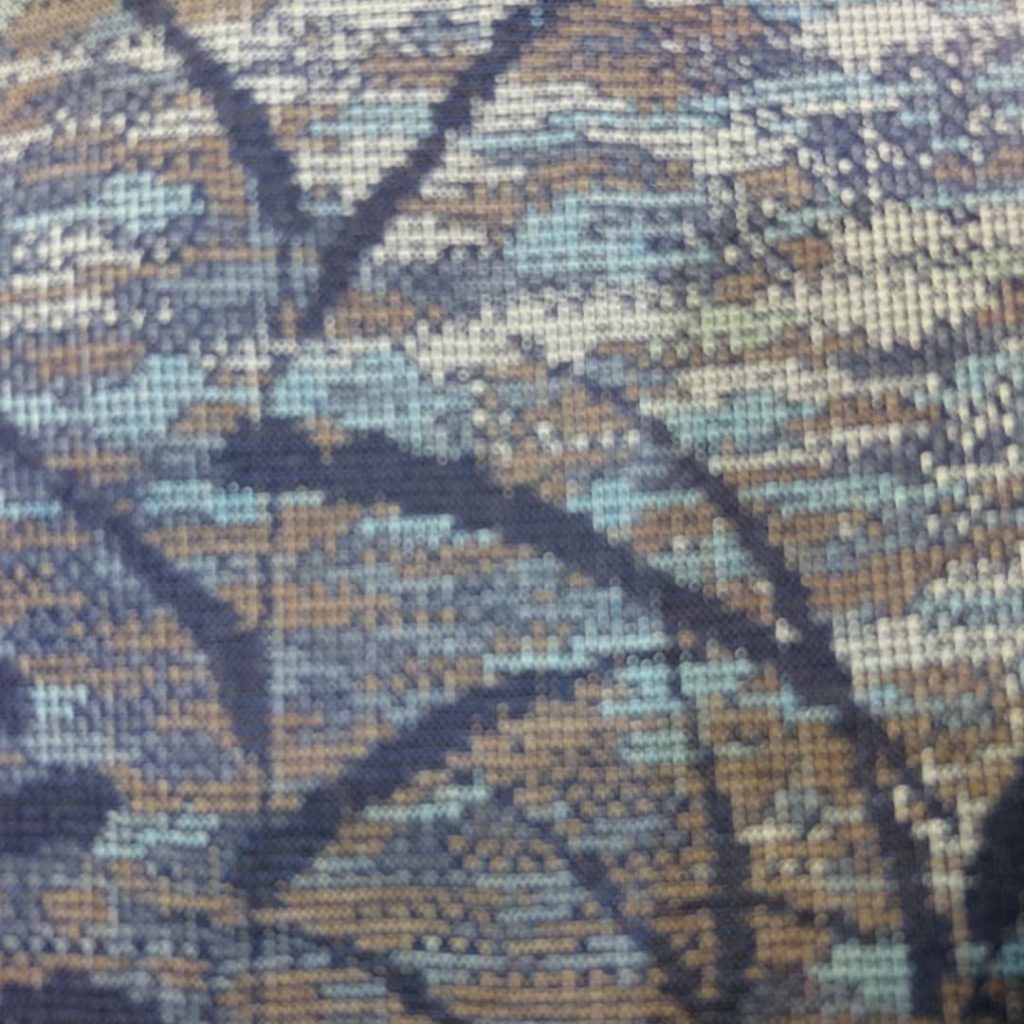
Yomi number
Some people may wonder, “What is the ratio of warp and ground yarn in 12 Maruki?” 12 Maruki is the same as 9 Maruki, and there are 2 ground threads for 1 warp. However, yomi number is different.
yomi number is a unit that expresses how many warp threads are in 1 cm. In Amami Oshima, it is traditionally woven with 13 yomi. In Kagoshima it is woven at 15.5 yomi.
13 yomi has 26 warp threads in 1 cm. (13 x 2 = 26)
15.5 yomi has 31 warp threads in 1 cm. (15.5 x 2 = 31)
By the way, Oshima Tsumugi of 12 Maruki is 18 yomi, and 36 warp threads are used in 1 cm. In the case of Oshima, the weft is a single kasuri-ito. The ratio of kasuri-ito and ground yarn to the warp represents Maruki, and the number of warp yarns between 1 cm represents yomi.
Oshima Tsumugi’s dignity
As the name suggests, Oshima Tsumugi is a tsumugi. No matter how expensive it is, you will wear it everyday. Kimono has nothing to do with price and dignity. You can’t wear it at a formal party. However, in the case of men, the pongee is dressed up, so you can wear it even in a formal place.
Also, unlike other kimonos, Oshima Tsumugi is dyed by immersing it in techi-gi’s broth or mud many times, making it water-resistant, so recently some people use it as a rain coat for kimonos.
This time, I told you the basics of Oshima Tsumugi. In the future, there will be various types of Kasuri and the meaning of the pattern of kasuri, so I would like to talk about it again. It is light and durable, and it is also resistant to water, so it is the best kimono to wear casually. One piece of Oshima Tsumugi weighs 450g, which is lighter than one PET bottle, so if you have a chance, please take a look.
